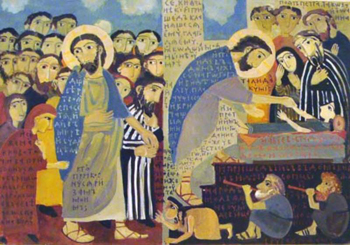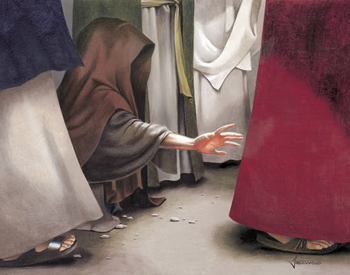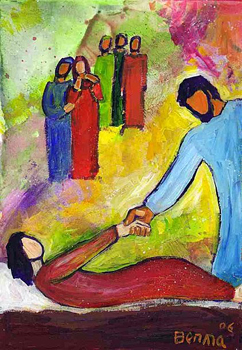For Sunday June 27, 2021
Lectionary Readings (Revised Common Lectionary, Year B)
Wisdom of Solomon 1:13-15, 2:23-24
Psalm 30
2 Corinthians 8:7-15
Mark 5:21-43
Our lectionary this week gives us a story of two daughters. One, a little girl on her deathbed, with an influential father to advocate for her. The other, an impoverished woman whose long illness has pushed her to the margins of society. Between them? Jesus. Jesus the healer. Jesus the restorer. Jesus, the scandalous and “unclean” boundary-crosser.
Like many stories in the Gospels, this one begins on the beach. Jesus and his disciples have just recrossed the Sea of Galilee from the Decapolis. They’ve hardly stepped off the boat when Jairus, a leader of the local synagogue, pushes through the crowd, falls at Jesus’s feet, and begs Jesus to heal his twelve-year-old daughter. Jesus agrees. As he, his disciples, and Jairus make their way to the synagogue leader’s house, a woman who has been hemorrhaging for twelve years pushes her way through the crowd, stretches out her hand, and surreptitiously touches Jesus’s cloak.
Immediately, her bleeding stops, and she feels within her body that she is healed. At the same instant, Jesus recognizes that power has gone out of his body, and he insists on finding out why. “Who touched my clothes?” he asks, turning to face the throngs of people behind him. It’s a ridiculous question; he's being jostled from all sides. But Jesus won’t budge. “Who touched my clothes?”
Just then — I imagine — the scene freezes.
There is so much I love about this story, not least of which is the fact that it centers around the embodied experiences of a girl and a woman. A girl who falls ill. A woman who bleeds. A daughter who suffers and dies too soon. A daughter whose intimate bodily suffering renders her an outcast.
Because there’s so much to notice and unpack, I want to begin by looking at each daughter’s story separately, and then think about why the Gospel writer might have chosen to connect them.
If you’re a parent whose child has ever been seriously ill, then your empathy for Jairus knows no bounds as you reflect on this Gospel story. I’m guessing that by the time the synagogue leader approaches Jesus, he has tried every medical and spiritual option available to save his child. He has pleaded with physicians. He has asked his colleagues and congregants to pray. He has used his considerable influence in the community to seek out innovative options. He has spent time and money without measure to find a solution. All to no avail.
 |
As the mother of two children with ongoing health challenges, my heart aches for Jairus. I can feel in my own body the desperation that compels him to throw professional caution aside and fall at the "heretical" Jesus’s feet. I can imagine hope warring with despair. Doubt warring with trust. Courage warring with fear. I can feel the relief and gratitude that flood through his heart when Jesus agrees to help his child. I can visualize the way he shoves and shouts his way through the too-thick crowd, asking Jesus again and again to please, please, please hurry. And I can feel too well the frenzy that boils up within him when Jesus — for no sensible reason whatsoever — suddenly stops. Right then, at the worst possible moment, when every microsecond matters. Stops for what? To ask a ludicrous and wholly irrelevant question: “Who touched my clothes?”
I don’t know about you, but I would have snapped. I would have cried and maybe screamed, knowing that relief was so close, and yet somehow still out of reach. We don’t know if Jairus snaps. All we know is that he learns to wait when waiting is the last thing on earth he can afford to do. He learns to wait, to trust, to breathe, to hang on — even at a moment when all seems lost. Even in a circumstance when Jesus makes no apparent sense. Even when Jairus receives word that his beloved child is dead, and he has to sit with the soul-crushing, mind-boggling question we all face at one time or another: “Jesus, why did you delay?”
Fast forward several minutes. Once the “interruption” of the bleeding woman is over, Jairus and Jesus continue on to the house, and Jairus has to learn another kind of faith. The faith to keep walking in the valley of death, simply because Jesus tells him to. The faith that endures past the worst news a parent can hear. The faith that holds steady in the face of mocking, disbelieving laughter. The faith that holds steady when despair wails. The faith that leans hard into resurrection. The faith that trusts an absurd and impossible word from God: “She is not dead but sleeping.”
There’s more to say about Jairus and his child, but let’s pause here and consider the other daughter in this story.
 |
According to Mark, this daughter has been bleeding for twelve years. Her condition renders her ritually unclean, which means she can’t enter the synagogue, the heart and soul of her religious community. She can’t touch or be touched by anyone without rendering them unclean, too. By the time she approaches Jesus, she has spent every penny she owns, enduring much under many physicians, but her bleeding has only worsened. The woman’s very body — its femaleness, its porousness — has become a source of isolation and disgrace. She’s an outcast, an embarrassment, a pariah. Lonely beyond description.
Given this context, it’s clear that what the woman does in approaching Jesus is a desperate and stunning act of civil disobedience. She knows she has no business polluting the crowds with her presence. She knows she’s forbidden to touch other people. She knows that even her fingertips on Jesus's cloak will defile him. But she touches him, anyway.
If the story ended there — with a stolen touch, an unremarked healing, and an invisible but still potent transformation of the woman’s life — I would consider it miracle enough. But no. Jesus invites more. He insists on more. He insists that the woman, terrified though she is, comes forward and tells her story. Her “whole truth.”
Jesus knows that this daughter has spent twelve long years having other people impose their narratives on her. Their interpretations, their assumptions, their prejudices. He knows that she’s been reduced to caricature. Shamed into silence by bad religion. Denied the spiritual nourishment and empowerment that is her birthright as a child of God. She needs someone to listen, to understand, and to bless her “whole truth” in the presence of the larger community.
So this is what Jesus does — even when time is of the essence, and he has essential work to do elsewhere. He pauses to restore a broken woman to fellowship, dignity, and humanity. He insists that her embodied experience is no less important than a synagogue leader's. He doesn’t allow her to slink away into obscurity; he invites her to bear witness, to find her voice, to speak publicly and confidently about her story and God’s. “Daughter,” he says when she at last falls silent. “Daughter, go in peace.”
As I wrote at the outset, each of these two healing stories is beautiful in its own right. But I’m interested in the fact that Mark connects them. Two daughters. Two references to “twelve years.” Two people who push through physical barriers (a teeming crowd), and religious taboos (the synagogue’s expectations of its leaders, and a culture's rules around uncleanness), to reach Jesus.
 |
Why? Why link these varied lives together? I’m speculating here, but I wonder what Jairus, the ultimate religious insider, experiences as he watches Jesus embrace and empower a bleeding, unclean woman, the ultimate religious outsider. I wonder if Jairus recognizes his own role — as an enforcer of the synagogue’s religious taboos — in the woman’s isolation and suffering. I wonder if he experiences a leveling, a reordering of who is "in" and who is "out" in God's economy. I wonder if he flinches when he realizes that the woman has made Jesus unclean by touching him. I wonder if he marvels at the fact that Jesus is wholly unconcerned with his own purity, that he proceeds straight to Jairus’s house anyway, bringing his “uncleanness” with him. I wonder if Jairus learns something about the danger of religious taboos. The importance of women's voices. The healing power of compassion.
We don’t know — but I hope so. I hope that when Jairus embraces his resurrected daughter, he also embraces a new vision of who God is, and what God values. In Jairus’s story, Jesus demands that we not see death where he sees life. In the bleeding woman’s story, he demands that legalism give way to love every single time. In each story, Jesus restores a lost child of God to community and intimacy. In each story, Jesus embraces what is "impure" (the menstruating woman, the dead body) in order to practice mercy. In each story, a previously hopeless daughter “goes in peace” because Jesus isn’t a pronouncer of death; he is a giver of new life.
So. What is “asleep” in us that Jesus might awaken? What do we have to push through in order to grab hold of God’s boundless compassion? What hierarchies, taboos, and skepticisms stand in our way? What is our “whole truth,” and when will we find the courage to tell it?
These are ancient and ever-living questions. They are our questions. May we ask them, face them, love them, and live into them.
Debie Thomas: debie.thomas1@gmail.com
Image credits: (1) The Rev. Astrid Storm; (2) Wandering and Wondering; and (3) A Trivial Devotion.





